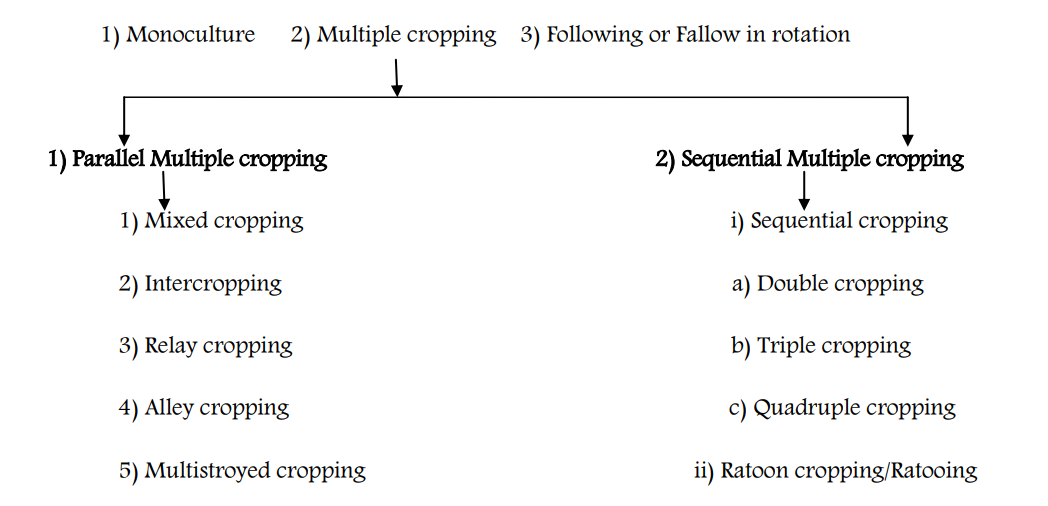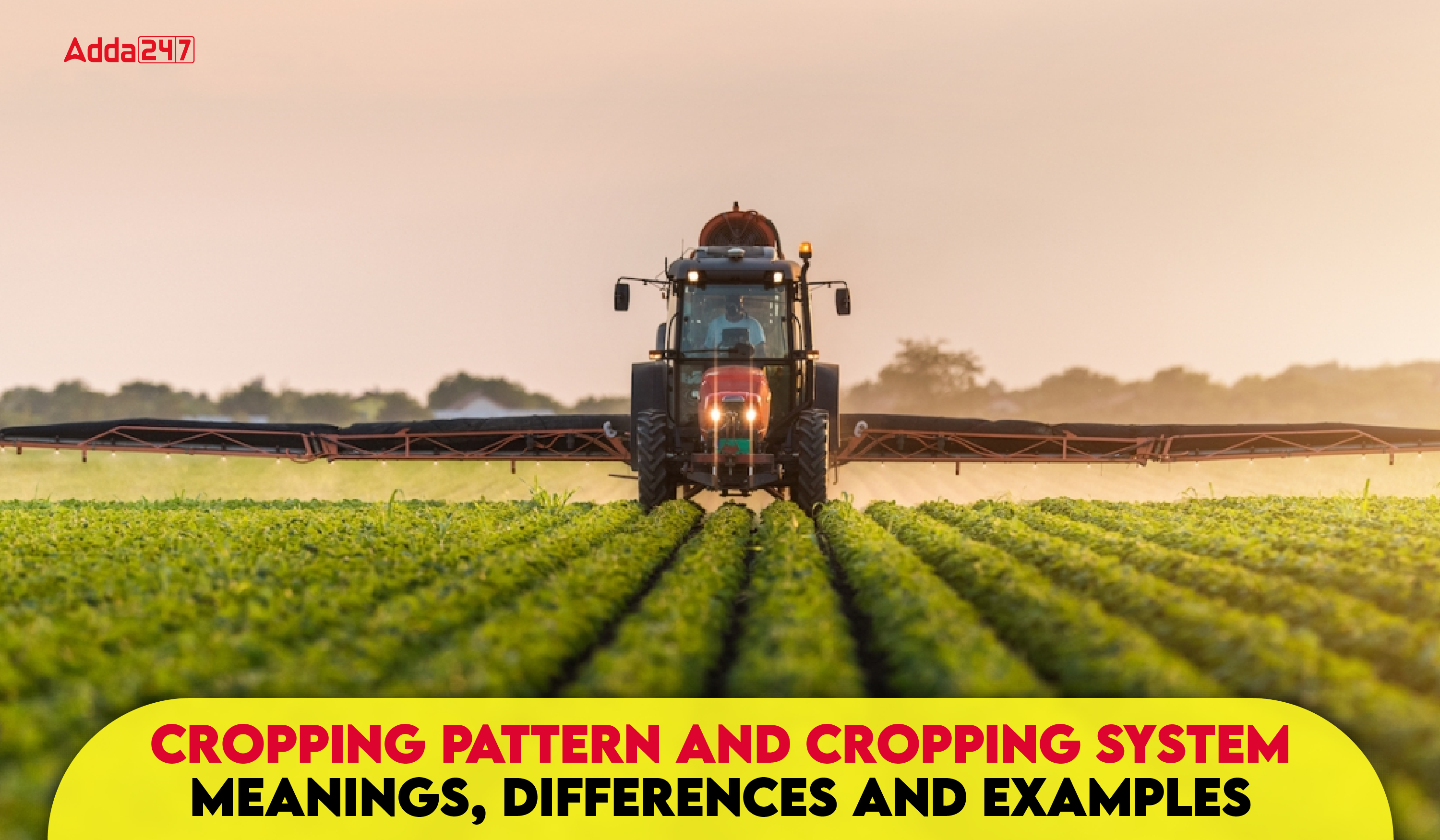A cropping system is a method used by farmers to plan and manage the crops they grow, aiming to make the best use of their land and resources. It involves deciding which crops to plant and when to plant them. This helps use the land more efficiently and can offer benefits like better pest control. Overall, a well-designed cropping system helps farmers increase productivity and optimize their farming practices. Let’s learn about the Cropping Pattern and Cropping System in detail here.
Cropping Pattern
Cropping pattern refers to the planned sequence and spatial arrangement of crops, or crops and fallow periods, on a specific piece of land over a year. It defines how different crops are rotated and positioned in the field throughout the growing season and across different seasons. For example, a cropping pattern might include planting wheat in the winter, followed by maize in the summer, or alternating between crops and fallow periods to restore soil fertility.
Cropping System
The cropping system is a broader concept that encompasses not just the cropping pattern but also the interaction of these patterns with the farm’s resources, other farm activities, and the technology available. It involves the strategic planning and integration of various cropping patterns on a farm to optimize overall productivity and sustainability. Different types of cropping systems are:

Types of Cropping Systems
Monoculture/Monocropping
Growing a single major crop repeatedly on the same land year after year. Examples include rice-rice and bajra-bajra.
Advantages:
- Convenience in sowing with the help of machinery under mechanized farming
- It is convenient for harvesting with the help of machinery
Disadvantages:
- Sometimes fertility and productivity of the soil are lowered if suitable soil management practices are not followed.
- Soil structure may be deteriorated.
- Increase infestation of pests, diseases, and weeds
Multiple Cropping:
Cultivating two or more crops in succession, sequence, or association on the same field within a year. Examples include sorghum-wheat-green gram and maize-wheat-green gram.
Types of Multiple Cropping:
- Parallel Multiple Cropping: Growing two or more crops in association with part or all of their life cycles.
- Mixed Cropping: Simultaneous growth of two or more crops without a distinct row arrangement, e.g., maize + green gram + pigeon pea.
- Sequential Multiple Cropping: Growing two or more crops in sequence on the same land over a year.
- Double Cropping: Two crops in sequence per year, e.g., black gram-jowar.
- Triple Cropping: Three crops in sequence, possible with irrigation, e.g., groundnut-wheat-okra.
- Quadruple Cropping: Four crops in sequence, possible under year-round irrigation, e.g., groundnut-coriander-wheat-green gram.
- Ratoon Cropping/Ratooning: Allowing crop regrowth after the initial harvest, e.g., ratooning of sugarcane.
Advantages:
- Increases total production and income.
- Facilitates year-round labor distribution.
Disadvantages:
- May deplete soil fertility and affect soil structure.
- Pest and disease management can be challenging.
Intercropping
Growing two or more crops simultaneously on the same land with distinct row arrangements.
Types of Intercropping
- Parallel Cropping: Crops with different growth habits are grown side by side, e.g., black gram + maize.
- Companion Cropping: Crops are grown in different rows with equal productivity, e.g., mustard + sugarcane.
- Mixed Intercropping: Two or more crops are grown without a distinct row arrangement.
Advantages:
- Improves soil fertility and productivity.
- Better resource utilization and reduced pest incidence.
Disadvantages:
- Difficult harvesting and intercultural operations.
- Increased competition for resources.
Types of Mixed Intercropping Systems
Mixed intercropping involves growing two or more crops simultaneously on the same piece of land to optimize space and resources. Here are four types of mixed intercropping systems:
1. Row Intercropping
Row Intercropping refers to the practice of growing two or more crops together, where one or more of the crops are planted in distinct rows. This method allows for clear spatial separation of the crops, which can help in managing and optimizing the growth conditions for each crop.
Example: Planting maize in rows with beans or peas between the rows of maize.
2. Patch Cropping
Patch Cropping involves growing different crops in separate patches or blocks within the same field. This system allows for varied crop management practices within the same field but ensures that crops are not intermingled. It is useful for crops that have different growth requirements or are sensitive to competition from other plants.
Example: Planting patches of potatoes and carrots in the same field but in separate areas.
3. Strip Intercropping
Strip Intercropping is the practice of growing two or more crops in adjacent strips wide enough to permit independent cultivation, but narrow enough to allow interaction between the crops. This system is designed to take advantage of the benefits of both crops while facilitating easier management and harvesting.
Example: Growing strips of maize and soybeans side by side, with each crop cultivated in its strip but close enough to benefit from each other’s presence.
4. Relay Cropping
Relay Cropping involves planting a succeeding crop before the preceding crop has been fully harvested. The succeeding crop is sown during the later stages of growth of the first crop, typically after it has reached its reproductive stage but before it is ready for harvest. This system aims to make efficient use of the growing season and available resources.
Example: Sowing lentils or chickpeas between rows of mature rice, allowing the succeeding crop to mature while the preceding crop is nearing harvest.
Alley Cropping
Growing arable crops in the alleys between rows of leguminous shrubs, e.g., maize between subabul rows.
Advantages:
- Improves soil fertility and provides fodder.
- Reduces cultivation costs.
Disadvantages:
- Increased competition for resources and potential crop failure.
- Competition among the natural resources i.e. moisture, nutrients, light, and space.
- The incidence of pests, diseases, and weeds is more.
- The chances of crop failure are more.
- Less yield is obtained.
Types of Alley cropping:-
- Food cum fodder system: In this system provides food grains like pulses, cereals, oilseeds, and fodder for livestock.
- Food cum mulch system: In this system provides food grains as well as crop residues as a mulch for soil and water conservative measures.
- Food cum pole system: In this system provides food as well as wood for fuel, timber, furniture, etc.
Multistorey Cropping
Growing crops of different heights and canopy layers together, e.g., growing pineapple and sweet potato under coconut trees.
Advantages:
- Optimizes moisture and nutrient use.
- Provides balanced food and enriches soil organic matter.
Disadvantages:
- Requires more space and labor.
- Increased pest and disease risks.
Sequential Multiple Cropping Systems
Sequential multiple cropping refers to growing two or more crops in succession on the same piece of land within a year or over a fixed period. This system aims to maximize land use and crop production by rotating crops in sequence.
Types of Sequential Multiple Cropping
Sequence Cropping:
Sequence cropping involves planting and harvesting crops in a specific order on the same land within a year. The key types of sequence cropping include:
- Double Cropping: This system entails growing two different crops sequentially on the same land within a single year. Examples include: Black Gram followed by Jowar, Black Gram followed by Wheat, Rice followed by Gram, and Groundnut followed by Wheat.
- Triple Cropping: Involves cultivating three distinct crops sequentially on the same land within one year. This is feasible primarily in areas with year-round irrigation. Examples include Groundnut followed by Wheat and Okra, Rice followed by Wheat and Groundnut, Jowar followed by Potato and Green Gram, and Soybean followed by Wheat and Groundnut.
- Quadruple Cropping: This system involves growing four different crops in sequence on the same piece of land within a year. It is typically practiced under irrigated conditions. Examples include Groundnut followed by Coriander, Wheat, and Green Gram, and Soybean followed by Methi, Wheat, and Green Gram.
Ratoon Cropping (Ratooning)
Ratoon cropping, or ratooning, involves the cultivation of crops that regrow from the stubbles or basal buds left after the harvest of the initial crop. This system allows for more than one harvest from a single sowing or planting. Examples of crops that benefit from ratooning include Sugarcane, Hybrid Jowar, Hybrid Bajra, and Redgram.
Advantages
- Increased Production and Income: Sequential cropping enhances the total production and gross monetary returns from the same unit area within a year.
- Diverse Crop Production: It fulfills various needs for food grains, pulses, oilseeds, vegetables, and fodder.
- Labor Distribution: Facilitates a more even distribution of labor throughout the year.
- Optimal Resource Utilization: Improves the use of land, labor, power, and other resources.
- Regular Income: Provides a steady flow of income throughout the year.
Disadvantages
- Soil Fertility and Productivity: Continuous cropping can lead to soil fertility depletion and reduced productivity if proper soil management practices are not followed.
- Soil Structure: Repeated cropping and irrigation might adversely affect soil structure.
- Pest and Disease Management: Managing pests, diseases, and weeds can become challenging with continuous cropping.
Definitions of Key Terms
- Base Crop: The major crop in an intercropping system.
- Intercrop: Additional crops grown in an intercropping system.
- Mixed Crop/Minor Crop: Crop grown by mixing seeds in a mixed cropping system.
- Main Crop: Major crop in a mixed cropping system.
- Companion Crop: Crop grown in association with a main crop for complementary effects.
- Component Crop: Crops grown together in a multiple cropping system.



 PNB LBO Exam Date 2025 Out, Written Exam...
PNB LBO Exam Date 2025 Out, Written Exam...
 Bank Exam Expected Schedule 2026-27 for ...
Bank Exam Expected Schedule 2026-27 for ...
 IB ACIO Tier 2 Admit Card 2025, Hall Tic...
IB ACIO Tier 2 Admit Card 2025, Hall Tic...




 Adda247 Job portal has complete information about all Sarkari Jobs and Naukri Alerts, its latest recruitment notifications, from all state and national level jobs and their updates.
Adda247 Job portal has complete information about all Sarkari Jobs and Naukri Alerts, its latest recruitment notifications, from all state and national level jobs and their updates.



